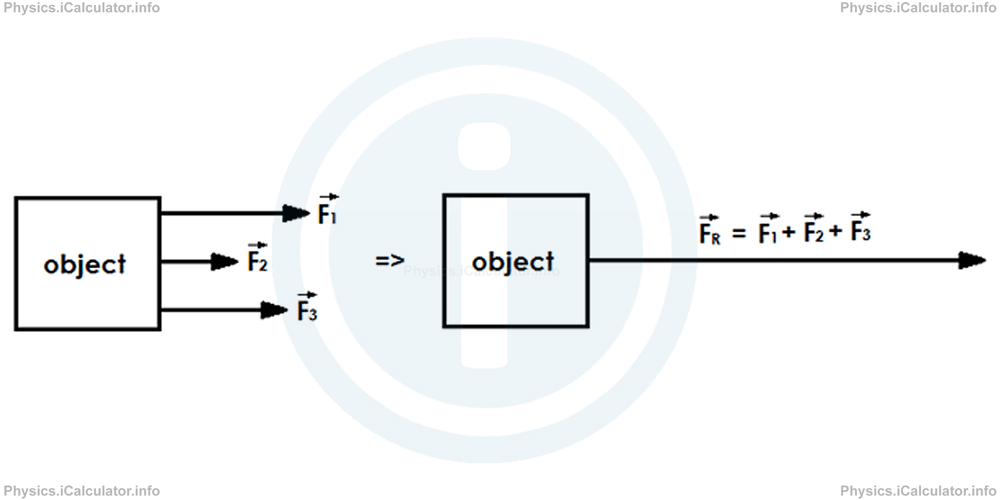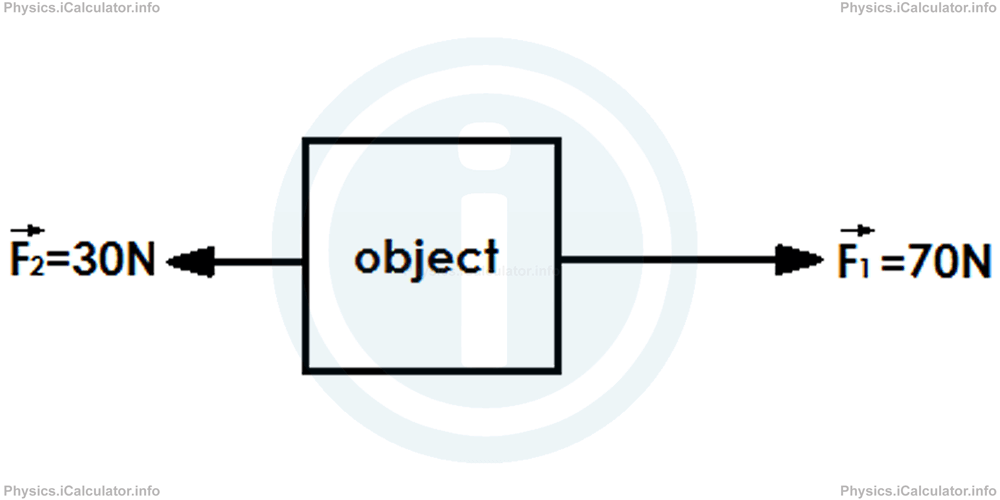Menu
Physics Lesson 4.1.3 - What is Resultant Force?
Please provide a rating, it takes seconds and helps us to keep this resource free for all to use
Welcome to our Physics lesson on What is Resultant Force?, this is the third lesson of our suite of physics lessons covering the topic of What Causes Motion? The Meaning of Force, you can find links to the other lessons within this tutorial and access additional physics learning resources below this lesson.
What is Resultant Force?
When two or more vectors act on the same object, an overall effect is produced. This effect (as discussed in the Physics tutorial "Addition and Subtraction of Vectors"), is known as resultant or net vector. In the specific case, we say when two or more forces act on the same object, the overall effect produced is called "resultant" or "net" force. Symbolically, we write F⃗R or F⃗net to express this overall effect that is nothing more but the sum of all forces acting on the same object. Look at the figure:

Numerically speaking, the effect on the object's motion caused by the resultant force is the same (in magnitude) as the effect of all single forces taken separately. For example, if in the above figure F⃗1 = 40N, F⃗2 = 20N and F⃗3 = 30N, the resultant force F⃗R will be
= 40N + 20N + 30N
= 90N
If possible, the length of the resultant force vector when compared to the lengths of each single force vector, must reflect their respective magnitudes. Thus, in the specific case, the vector F⃗1 is the longest and the vector F⃗3 is the shortest as this description corresponds to their numerical values. Also, the force vector F⃗R is longer than each single force vector as it represents their sum.
On the other hand, if two forces act in the opposite direction, the first thing to do is to choose a positive direction. As a result, one force (the one that lies in the positive direction) is taken as positive and the other as negative. For example, in the figure below,

we take F⃗1 as positive and F⃗2 as negative. Therefore, we obtain for the resultant force:
= 70N + (-30)N
= 70N - 30N
= 40N
This means the resultant of two forces acting in the opposite direction (which in this case is 40N due right) represents their numerical difference (this derives from the fact that subtraction is the opposite operation of addition).
You have reached the end of Physics lesson 4.1.3 What is Resultant Force?. There are 4 lessons in this physics tutorial covering What Causes Motion? The Meaning of Force, you can access all the lessons from this tutorial below.
More What Causes Motion? The Meaning of Force Lessons and Learning Resources
Whats next?
Enjoy the "What is Resultant Force?" physics lesson? People who liked the "What Causes Motion? The Meaning of Force lesson found the following resources useful:
- Resultant Force Feedback. Helps other - Leave a rating for this resultant force (see below)
- Dynamics Physics tutorial: What Causes Motion? The Meaning of Force. Read the What Causes Motion? The Meaning of Force physics tutorial and build your physics knowledge of Dynamics
- Dynamics Revision Notes: What Causes Motion? The Meaning of Force. Print the notes so you can revise the key points covered in the physics tutorial for What Causes Motion? The Meaning of Force
- Dynamics Practice Questions: What Causes Motion? The Meaning of Force. Test and improve your knowledge of What Causes Motion? The Meaning of Force with example questins and answers
- Check your calculations for Dynamics questions with our excellent Dynamics calculators which contain full equations and calculations clearly displayed line by line. See the Dynamics Calculators by iCalculator™ below.
- Continuing learning dynamics - read our next physics tutorial: Types of Forces I. Gravitational Force and Weight
Help others Learning Physics just like you
Please provide a rating, it takes seconds and helps us to keep this resource free for all to use
We hope you found this Physics lesson "What Causes Motion? The Meaning of Force" useful. If you did it would be great if you could spare the time to rate this physics lesson (simply click on the number of stars that match your assessment of this physics learning aide) and/or share on social media, this helps us identify popular tutorials and calculators and expand our free learning resources to support our users around the world have free access to expand their knowledge of physics and other disciplines.